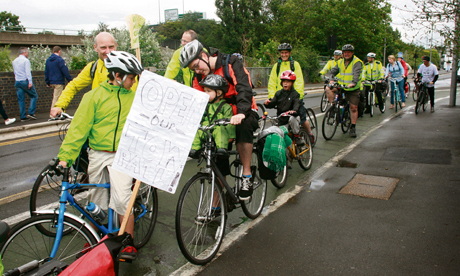River Lea towpath closure troubles residents

Open Our Towpath protestors at the start of their ride. Photograph: Hackney Citizen
Five years of noise pollution and dust, an arts festival that didn’t quite happen, house boats forced to move on and now the army on their doorstep: the residents of the River Lea at Hackney Wick have really had to bear the brunt of London’s Olympic upheaval.
Without warning, on 3 July, the area of The River Lea Navigation towpath that runs alongside the Olympic Park was closed off to the public. The explanation given by officials for this action was simply stated as ‘Olympic security’ reasons.
The closed section of Cycle Route 1 runs from the Eastway Bridge in Hackney Wick to the edge of the Bow roundabout. The path was originally promoted as the ‘Green Route to the Games’. For it to be shut without warning just 23 days before the Games until the end of the Paralympics has angered and frustrated residents, many of whom rely on the route to get into work every day.
Open our Towpath is a group of Hackney Wick residents, cyclists and pedestrians that formed to campaign against this sudden and controversial decision.
I joined the group on Sunday 29 July as they mobilised for their fourth demonstration against the closure. We congregated on the towpath under the Eastway bridge for a bicycle ‘flashride’.
The purpose of the flashride was to ‘ride the diversion’ – in other words, to follow the suggested Olympic diversion routes for the closed river path and highlight the danger of these suggestions.
Both Travel London 2012.com and the Transport for London (TfL) website offer a myriad of confusing alternatives to the fast and direct canal towpath; none of them seem to be logical or straightforward.
Dee O’Connell, who runs a vintage clothes business and lives at Wick Village, attended the flashride, saying: “We don’t understand why they have done this. There is a six metre Olympic fence with cameras and movement sensors on it, they have put so much money into doing up the towpath and now it is a dead zone”.
Other members and Wick residents present at Sunday’s demo were equally disgruntled at the official ‘security’ line: “The whole Olympics is about persuading people to come out and enjoy leisure pursuits and yet they cut off the canal. Nobody will actually respond. They just say it is a security issue,” said local resident Patrick Looney.
With a seemingly sympathetic crew of policemen – on bikes – accompanying us, we set off on a journey that eventually took us to the Abbey Lane cycle parking area in Newham, a designated bicycle safe space for those visiting the East entrance to the Olympic Park.
Following a map, we navigated a diversion route en mass, facing back roads, footpaths and dead ends. Some noteworthy moments included: a treacherous turning onto Bow road, some misplaced, unhelpful temporary yellow signs for cyclists and of course the Bow flyover.
Our police escorts would not allow us onto the notorious Bow roundabout so we took to the flyover, negotiating lane changes and following traffic. The whole experience of the diversion route was confusing, convoluted, slow, and at times, scary.
Other similarly disorientating changes to Hackney Wick’s road and travel network have been the total closure of the Greenway to cyclists and more recently, the afternoon closure of the westbound train platform at Hackney Wick Overground station.
There are many unanswered questions, including why LOCOG has decided to implement such extreme ‘security’ measures in Hackney Wick at such a late hour and why local people are still not being listened to.
